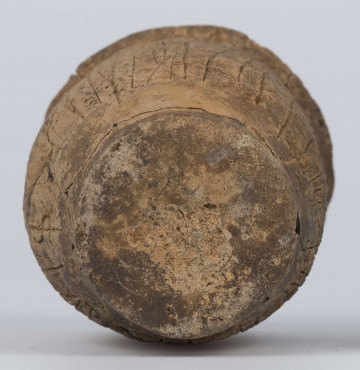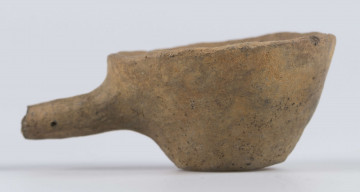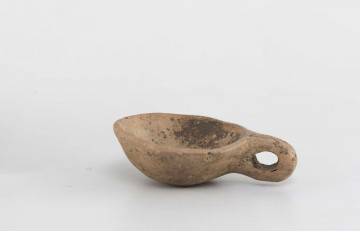
S-shaped vessel
III-V period
National Museum in Lublin
Part of the collection: European painting
The painter's name and the date appear on the edge of the table: 'HV: HEEMSKERCK:1652'. The author of the painting is Hendrick Cornelisz van Heemskerck known only from a few preserved works. We know little about him other than that he lived between 1629 and 1681 and belonged to the guild in Leiden. He was one of the many painters of the 17th-century, later called the golden age of Dutch painting.
A genre called still life, in Dutch stilleven, translated as a quiet life, was popular at that time. Its subjects were realistically portrayed objects, luxurious but also of everyday use. The stoneware jug decorated with plastic overlays and a hinged tin lid was made in the Westerwald. The renowned pottery centre in central Germany then supplied a vast area from Gdańsk to Amsterdam. The two white pipes represent the classic type of Dutch clay pipe with a long stem and a small head. The crumpled piece of paper is probably a letter read, which can now join the bundle of scrolls beside it. Unnecessary pieces of paper were rolled up into the so-called spills for lighting, used to carry the fire from the hearth or candle to the pipe. After all, it would be 200 years before the first match was made. The brass candlestick, like the glass, had a form typical and popular in Europe. The wax candle has just gone out, and it glows, leaving a barely visible trail of smoke.
The precision in rendering details proves the painter's keen observation and sensitivity to the beauty of objects, but above all, it shows his mastery of the craft of painting. Thanks to him, the diversity of the matter has been so perfectly conveyed: the massive weight of the oak table, the metallic gloss of the candlestick and the lid, the transparency of fragile glass, the soft folds of woollen fabric. The painter limited the range of colours, creating an almost monochromatic image, reduced the number of props to a minimum, and at the same time carefully studied each of them, achieving an impression of peace and duration. That is what fascinated him the most – the 'quiet life' of objects bearing the trace of the presence of a human who was just there – he drank wine, read a letter, smoked a pipe in which there is still a flicker of embers, and left... The apparently banal scene turns into a morality play expressing the truth about the insignificance of earthly matters, the transience of life, which is contained in one word – vanitas.
Barbara Czajkowska
Author / creator
Dimensions
cały obiekt: height: 65,5 cm, width: 49 cm
Object type
painting
Technique
oil technique
Material
plank, oil-based paint
Creation time / dating
Creation / finding place
Owner
The National Museum in Lublin
Identification number
Location / status

III-V period
National Museum in Lublin

National Museum in Lublin

National Museum in Lublin
DISCOVER this TOPIC
Museum of King Jan III's Palace at Wilanów
DISCOVER this PATH
Educational path